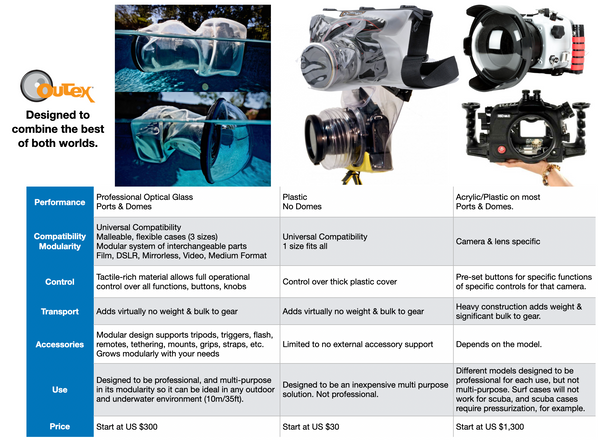Underwater Camera Case Comparison Chart
Apr 10, 2023
What Makes the Best Underwater Housing System for Cameras
All products have pros & cons, so it's best think in terms of "what's the best underwater case for me and my purposes. A little upfront research can help you make the best choice. Here's a summary. The Outex underwater housing system combines the best attributes of both ends of the waterproofing spectrum. It's the best optical performance because it uses optical glass ports (not plastic/acrylic), and it enables control over all camera & lens functionality. It's compatible with all camera and lens brands & models, film, dslr, mirrorless, video, and medium format. It's an upgradeable system of exchangeable, compatible parts, just like your camera, so it grows with your needs, and works with tripods, triggers, flash, tethering, mounts, grips, and more. It's super travel friendly, adding no weight or bulk to your gear. And it's affordable. Here's some competitive analysis below.

Plastic Bags
- On one end of the spectrum, bags are inexpensive and fit most cameras.
- Bags are made of all plastic, making them lightweight and compact (travel-friendly).
- They are often one-size-fits-all and not molded or conforming to camera gear. The plastic restricts tactile feedback and limits the ability to navigate your camera and lens controls, including focus. Users report a clumsy experience, like using oven mitts.
- Most of them are not optimal for image quality since you’re shooting through plastic or acrylic at best. This has a degrading effect on image quality.
- High-end bags offer acrylic optical ports for the lens, but they do not connect to the camera, and the lens is floating inside, forcing the user to negotiate focal length, viewing angle, and focus through the port opening, causing vignetting on wide-angle lenses.
In conclusion, bags are cheap options, and you get what you pay for. Not a professional solution, but convenient for the occasional user.
Hard-cases
- At the other end of the spectrum, hard cases require a serious financial investment.
- Hard cases are often built for specific uses, such as scuba diving or surfing. For example, a surf housing is not suited for diving because it is heavy and bulky. And a dive housing may rely on pressure for its seal, making it a poor choice for shallow use (such as a pool).
- Hard cases are built for specific camera models. The buttons are set and you cannot use a different model camera in that housing. The buttons are often not specifically aligned based on physical constraints, so a camera’s back button may be on the side of the housing, for example, or vice versa. These housings often don’t accommodate all of your settings either, not all functionality is supported. Cases also prevent LCD screen use.
- Dive-specific cases can resist pressure upwards of 80-100 feet in depth (24-30 meters).
- The hard materials add impact-protection to the camera. They protect the camera/lens if/when hit.
- Most hard cases use plastic ports (acrylic), despite the high cost. Acrylic scratches more easily than glass but can withstand more underwater pressure at depth. Only a few high-end models offer optical glass port options.
- Hard cases are also difficult to transport because they are heavy and bulky, often requiring custom heavy-duty transport cases. These factors can significantly increase the overall cost of the case and also increase travel costs such as luggage fees on airlines, trains, cars, etc.
In conclusion, dedicated hard cases are the ideal solution for specific uses and dedicated cameras and lenses. They offer professional optical results if the expense and transport constraints are not an issue.
Outex system combines the best of both worlds.
- Outex offers professional results, a universal design for multiple cameras and lenses, complete functional control of all settings, modular upgradeability based on growing needs, transport friendliness, and affordability.
- Because all its front ports are made of American-made optical glass, Outex outperforms most underwater housings in terms of image quality capability – both flat and dome ports. Our front glass also becomes one with every lens by attaching to the lens’s filter thread, which ensures it moves with it, and accommodates for focal length, and guarantees no zooming or wide-angle vignetting at all of the lens’ focal lengths.
- The flexible, malleable, molded housing design stretches to accommodate the gear and maintains tactile control, and optimizes dexterity and user-feedback. This means it accommodates any camera or lens, regardless of brand, make, or model, whether it’s film, DSLR, Mirrorless, Medium Format, etc.
- The patented housing design also means the user can access all of the camera and lens’ functionality – controls, buttons, focus, rings, knobs, and even touch-LCD access.
- The cover’s tactile feedback means you don’t have to re-learn how to operate your camera. All the buttons are familiar, and you have access to all of them, which enables you to completely change settings in mid-shoot without having to remove it from the housing.
- The Outex product line functions like LEGOS, in that they are a system of parts that work together interchangeably. You can mix and match as desired, so you can use different cameras, lenses, tripods, cables for tethering, lighting, etc. You can purchase incremental parts as needed, and they work with the Outex products you already have.
- The lightweight and compact design adds virtually no weight or bulk to the gear, making it ideal for use in any environment (not just underwater) – sand, dust, dirt, mud, spray, paint, etc. It also makes it ideal for travel and transport.
- Outex products can be purchased a la cart or as ready-made kits. Covers start at $99 USD, and kits start at $295 USD.
- Outex is tested to 10 meters or about 33 feet underwater. The housing is not so sensitive to water pressure, and we’ve had customers go twice that deep, but we do not recommend it. Below a certain depth, the water pressure will start pressing your camera’s buttons and it will eventually not operate properly until you return to shallower depths.
- Outex does not protect the gear internally from impact.
In conclusion, Outex is a great all-around solution for professionals or enthusiasts using multiple cameras or lenses in various environments – rain, dirt, mud, sand, dust, etc. – and not just in one particular field. Its modular design and affordability is the reason so many professionals make Outex part of their arsenal, even if they also use other dedicated housings.
Outex Product Overview
Optical Imaging Quality
Outex housings feature high-quality optical glass that ensures distortion-free images and accurate colors. Optical glass is better than acrylic/plastic. That's why your lenses are made of glass - not acrylic. Many competitors use acrylic or polycarbonate lenses, which can compromise image sharpness and scratch much more easily. Outex optical glass ports are the best imaging solution in the market.
In addition, or ports (flat and domes), which are all made of optical glass, conform to each lens, which positions them optimally for optical results. The Dome itself is universally compatible, and its clamps and adaptors conform to the specifications optics of each lens, positioning them optimally and delivering ideal results. By contrast, most lenses, "float" inside hard case housings, so you may end up with vignetting, or other impediments to use. With Outex you know the positioning and fit will match to optimize the imaging characteristics of the specific lens being used, delivering the best results each time.



